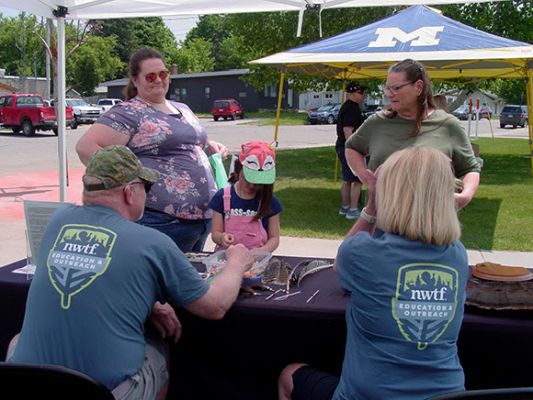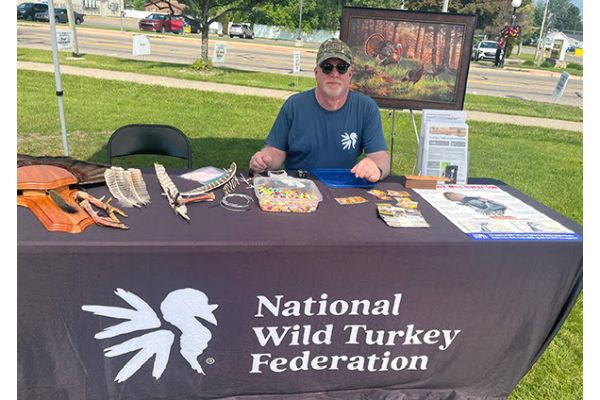EDGEFIELD, S.C. — The Kirtland’s Warbler Festival has been actively celebrating the songbird’s conservation success for over 30 years. This year, the Michigan NWTF State Chapter was invited to be part of the celebration.
For those who may have never heard of the Kirtland’s warbler, it’s because almost the entire population breeds in north-central Michigan.
This warbler shares a similar story to the wild turkey in that it was on the verge of extinction due to habitat loss. In the late 80s, there were only 167 singing males recorded. Thanks to habitat management programs that included managed burns, clear-cutting and the planting of Jack pines, as well as the monitoring and control of nest-parasitizing cowbirds, the number of singing males rebounded to over 2,300 by 2015.
Mike Petrucha, now the festival’s chair, vice chair, treasurer and secretary, was a part of the efforts to reestablish the lost habitat when he was working for the U.S. Fish and Wildlife Service.
“Jack pines get in your blood,” Petrucha said. “It makes good deer habitat, and when it’s young, it’s the best snowshoe hare habitat there is. Turkeys certainly use it, especially the openings, which are grassy with lots of grasshoppers and insects for them to eat. Ruffed grouse, spruce grouse and bears use it as well.”
Petrucha transferred to the Michigan Department of Natural Resources, where he worked until he retired. In this position, he was a part of the live turkey trap and transfer programs. Early in his career at Michigan DNR, he remembers there were conifer plantings that the NWTF funded.
“I remember growing up in Michigan, I never saw a turkey,” Petrucha said. “I was born in 1962, and all the way through high school, I never saw turkeys anywhere. Now I have to chase them out from underneath my bird feeder sometimes because they’re eating all the seeds!”
It seems only fitting that he was the one to bring the Kirtland’s warbler and the wild turkey together. It has been his goal for a few years to involve everybody that has anything to do with the outdoors in the local area at the festival.
“Hunting and fishing are such a big part of northern Michigan that I figured we needed to have representatives there to show people that this festival isn’t just about one bird,” Petrucha said. “It’s an educational celebration of the Kirtland’s warbler, it’s habitat and the communities located in the Jack pine ecosystem, which encompass hunting species.”
While he was planning this year’s festival, he invited hunting and fishing organizations to attend and table at the festival. NWTF volunteers were the only organization that responded.
Michigan State Chapter President Jon Gray received the email from Petrucha and immediately knew the NWTF would attend the festival one way or another. Since Gray was elected president a year and a half ago, one of his goals has been to try and increase the NWTF’s visibility.
“We wanted to take advantage of any opportunity to set up a table and talk to people about what the NWTF does and who we are,” Gray said. “So, this was a great opportunity to connect with people outside of the turkey hunting crowd.”

The NWTF has partnered on numerous habitat projects in Michigan that have benefitted both wild turkeys and Kirtland’s warbler, including pine-barren restoration through the MDNR’s Wildlife Habitat Grant Program.
Gray had a handout summary that listed all of the state’s accomplishments from 2024. He also brought dried turkey legs, a beard, a tail fan and some wing feathers from harvested birds for visitors to look at. They also had supplies for people to make their very own turkey call.
“Whether they were four or 84 years old, they were making these turkey calls out of coffee stirrer straws, some turkey feathers and beads,” Gray said. “It was a really good and informal way to talk to them. If they had questions while they were making their calls, then we were able to talk to them about turkeys while they were there.”

Petrucha later recalled that the NWTF table was busy during the entire festival.
“There were a lot of kids there, which is good,” Petrucha said. “You’ve got to teach them when they’re young, before they learn other biases that may not be true, and we need to get more kids into hunting and fishing.”
Overall, the NWTF volunteers spoke to over 150 people about wild turkeys and the NWTF’s mission. At next year’s festival, Petrucha hopes to get even more involvement from other organizations.
“I think we would have more of an impact if we all [hunting and conservation organizations] worked together, because improving habitat is all of our common goal,” Petrucha said.
About the National Wild Turkey Federation
Since 1973, the National Wild Turkey Federation has invested over half a billion dollars into wildlife conservation and has positively impacted over 24 million acres of critical wildlife habitat. The NWTF has also invested over $10 million into wild turkey research to guide the management of the wild turkey population and to ensure sustainable populations into perpetuity. The organization continues to deliver its mission by working across boundaries on a landscape scale through its Four Shared Values: clean and abundant water, healthy forests and wildlife habitat, resilient communities, and robust recreational opportunities. With the help of its dedicated members, partners and staff, the NWTF continues its work to provide Healthy Habitats. and Healthy Harvests. for future generations.
Read the full article here




